Gardening has always been about more than just growing plants—it’s about connecting with nature, creating beauty, and cultivating sustainability. But in today’s world, where climate change and environmental concerns are front and center, many gardeners are looking for ways to make their outdoor spaces greener in every sense of the word.
The good news? Eco-friendly gardening doesn’t require expensive equipment or complicated methods. In fact, some of the most effective hacks are simple, practical, and proven to work. From conserving water to repurposing kitchen scraps, these 10 eco-friendly gardening hacks will help you reduce waste, protect the planet, and keep your garden thriving naturally.
1. Collect Rainwater for Irrigation

Why use treated tap water when nature provides its own supply? Installing a rain barrel or simple collection system lets you harness free, chemical-free water for your plants.
- How to do it: Attach a rain barrel to your home’s downspout. Add a spigot at the bottom for easy watering access.
- Benefits: Reduces water bills, prevents stormwater runoff, and gives plants softer water that’s free of chlorine and fluoride.
- Extra tip: Cover your barrel with a fine mesh screen to keep out debris and mosquitoes.
2. Compost Kitchen Scraps
Food waste doesn’t belong in landfills—it belongs in your garden. Composting turns banana peels, coffee grounds, and vegetable scraps into nutrient-rich soil.
- How to do it: Use a compost bin or pile in a shady spot. Balance “greens” (food scraps, grass clippings) with “browns” (dry leaves, shredded cardboard).
- Benefits: Cuts household waste by up to 30%, enriches soil, and reduces the need for chemical fertilizers.
- Extra tip: Crushed eggshells add calcium, while coffee grounds help acid-loving plants like blueberries and azaleas.
3. Embrace Mulching

Mulching is one of the simplest yet most powerful eco-friendly gardening techniques.
- How to do it: Spread organic mulch—such as shredded leaves, bark, or straw—around plants.
- Benefits: Conserves water by reducing evaporation, suppresses weeds, and improves soil health as it decomposes.
- Extra tip: Use grass clippings as mulch—but let them dry first to avoid matting.
4. Grow Native Plants
Choosing plants that naturally thrive in your region reduces maintenance and conserves resources.
- Why it works: Native plants are adapted to local soil, rainfall, and pests, meaning they require less watering, fertilizing, and spraying.
- Benefits: Supports local pollinators, strengthens biodiversity, and reduces invasive species problems.
- Extra tip: Check local extension offices or native plant societies for species recommendations.
5. Use Companion Planting

Nature already knows how to create balance—companion planting mimics those systems.
- How it works: Pair plants that help each other grow. For example:
- Basil deters pests from tomatoes.
- Marigolds repel nematodes and aphids.
- Corn, beans, and squash (the “Three Sisters”) thrive symbiotically.
- Benefits: Reduces pesticide use, improves yields, and promotes natural pest control.
6. Repurpose Household Waste
Your trash can be your garden’s treasure.
- Ideas to try:
- Use old newspapers or cardboard as weed barriers under mulch.
- Repurpose glass jars as mini greenhouses for seedlings.
- Turn plastic bottles into drip irrigation systems.
- Benefits: Saves money, reduces landfill waste, and sparks creativity.
7. Attract Pollinators Naturally

Bees, butterflies, and hummingbirds are your garden’s best allies.
- How to do it: Plant nectar-rich flowers like lavender, sunflowers, and coneflowers. Include a mix of blooms for spring, summer, and fall.
- Benefits: Boosts pollination, increases harvests, and supports declining pollinator populations.
- Extra tip: Avoid chemical pesticides that harm beneficial insects.
8. Make Natural Fertilizers
Skip synthetic fertilizers and feed your plants the natural way.
- DIY options:
- Banana peel tea: Soak banana peels in water for a potassium-rich boost.
- Epsom salt spray: Adds magnesium to help plants grow strong.
- Weed tea: Soak weeds in a bucket of water for a few weeks, then use as liquid fertilizer.
- Benefits: Healthier soil, cost savings, and less chemical runoff into waterways.
9. Conserve Water with Smart Techniques
Water is a precious resource, and your garden doesn’t need as much as you think.
- Strategies to try:
- Water early in the morning to minimize evaporation.
- Use soaker hoses or drip irrigation instead of sprinklers.
- Group plants with similar water needs together.
- Benefits: Saves water, cuts costs, and prevents plant stress.
10. Create a Wildlife-Friendly Habitat

A truly eco-friendly garden supports more than just plants—it nurtures an ecosystem.
- How to do it: Add a birdbath, a bee hotel, or a small log pile for beneficial insects. Leave a corner of your yard “wild” to encourage biodiversity.
- Benefits: Attracts natural pest controllers like birds and ladybugs, reduces reliance on chemicals, and supports local wildlife.
- Extra tip: Even a small urban garden can become a sanctuary for pollinators and songbirds.
Final Thoughts
Eco-friendly gardening doesn’t mean sacrificing beauty or convenience—it means working with nature instead of against it. By collecting rainwater, composting, planting natives, and using smart, sustainable techniques, you’ll not only create a healthier garden but also contribute to a greener planet.
These 10 hacks are practical, affordable, and proven to work. Start with one or two, and soon your garden will become a thriving, sustainable oasis that benefits you, your neighbors, and the environment alike.

Leave A Comment